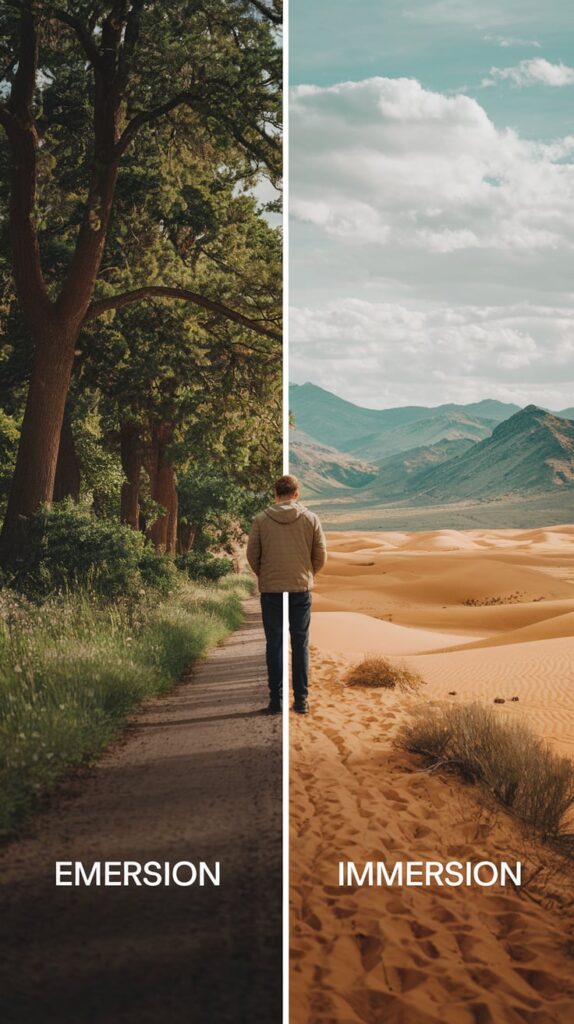When exploring the terms emersion vs immersion, it’s essential to understand how these concepts influence our experiences and perceptions. Although they sound similar, emersion vs immersion highlights two distinct processes that shape our interactions with the world.
In this article, we’ll delve into the meanings, differences, and practical examples of both terms. By the end, you’ll have a comprehensive understanding of emersion vs immersion and how they apply in various contexts.
Understanding Emersion and Immersion
What is Emersion?
Emersion refers to the act of coming out from a submerged state or a position of concealment. Imagine a fish surfacing after being underwater; that moment captures the essence of emersion.
This concept isn’t limited to physical experiences; it can also apply to emotional and psychological states, symbolizing breakthroughs or realizations.
What is Immersion?
In contrast, immersion involves being fully absorbed or engaged in a particular activity or environment. Think of a student in a language class who is completely focused on learning.
They are not just passively receiving information; they are actively participating and experiencing the language in a rich, contextual setting.

The Key Differences
The fundamental difference between emersion vs immersion lies in their nature: one focuses on emerging from something, while the other emphasizes deep engagement. Emersion signifies a transition to visibility, whereas immersion describes a profound connection with an experience.
20 Key Distinctions Between Emersion and Immersion
- Nature of Action: Emersion implies coming out; immersion means going in deeply.
- Visibility vs. Absorption: Emersion leads to visibility; immersion results in total absorption.
- Intent: Emersion can be involuntary; immersion is usually a conscious choice.
- Context: Emersion often describes physical transitions; immersion relates to psychological engagement.
- Duration: Emersion can be temporary; immersion tends to be long-lasting.
- Environmental Change: Emersion may pertain to changes in visibility due to natural elements; immersion involves full sensory engagement.
- Educational Focus: Emersion might reflect a shift in understanding; immersion signifies active learning and participation.
- Psychological Impact: Emersion represents a form of release; immersion fosters a sense of connection.
- Creative Processes: Emersion indicates a transition in creativity; immersion emphasizes deep involvement in the creative process.
- Technological Applications: Emersion can be seen in virtual reality when transitioning from a virtual space; immersion highlights the experience within that space.
- Cultural Experiences: Emersion refers to adapting to cultural differences; immersion involves living within and experiencing a culture fully.
- Therapeutic Practices: Emersion may represent a breakthrough in therapy; immersion can enhance mental health through deep engagement in activities.
- Experiential Learning: Emersion shows what you leave behind; immersion emphasizes what you enter.
- Personal Growth: Emersion symbolizes a new beginning; immersion leads to deep self-discovery.
- Connection vs. Disconnection: Emersion can signify a detachment, while immersion fosters connections with ideas and people.
- Artistic Representation: Emersion can be used metaphorically for a character’s awakening; immersion captures the reader’s engagement with a story.
- Marine Biology: Emersion applies to organisms surfacing as tides go out; immersion relates to studying these organisms in their natural habitat.
- Psychological Engagement: Emersion can indicate emerging from stress; immersion fosters deep psychological engagement in a task.
- Social Interactions: Emersion reflects stepping out of one’s comfort zone; immersion entails fully engaging in social settings.
- Temporal Nature: Emersion can be a fleeting moment; immersion often leads to long-term impacts and transformations.
30 Points About Emersion and Immersion
Emersion
- Definition: The act of emerging from a submerged state.
- Example: A turtle coming out of its shell.
- Visual Transition: Indicates a shift from hidden to visible.
- Cultural Interpretation: Symbolizes growth or revelation within cultural contexts.
- Environmental Changes: Relates to natural occurrences like tides and seasonal changes.
- Therapeutic Uses: Emersion can represent grounding techniques in therapy.
- Symbolism: Often signifies breakthroughs or new beginnings.
- Artistic Expression: In literature, it can represent a character’s awakening.
- Psychological Aspect: Emersion can indicate overcoming obstacles or fears.
- Personal Development: Represents stepping out of old patterns into new experiences.
- Educational Contexts: Emersion can show a shift in a student’s understanding.
- Nature Metaphors: Often used to describe animals surfacing after being hidden.
- Communicative Aspect: Emersion can reflect clearer expression after a period of confusion.
- Emotional Release: Represents breaking free from past constraints.
- Social Situations: Emersion may occur when someone re-enters society after isolation.
- Physical Activities: A swimmer breaking the surface of the water exemplifies emersion.
- Literary Devices: Authors often use emersion as a metaphor for enlightenment.
- Technological Advances: In gaming, it describes a player’s return to the real world after a session.
- Existential Themes: Emersion can symbolize finding purpose or direction.
- Metaphorical Use: Emersion is frequently used in discussions about self-improvement.
Immersion
- Definition: Deep engagement in an experience or activity.
- Example: Participating in a language immersion program.
- Cognitive Focus: Relates to how deeply one engages with material.
- Active Participation: Involves intentional and conscious involvement.
- Sensory Engagement: Engaging all senses for a complete experience.
- Cultural Deep Dive: Living within a culture to learn and experience it fully.
- Learning Environments: Essential for experiential learning techniques.
- Technological Integration: Enhances learning through virtual and augmented reality.
- Creative Processes: Can lead to innovation and artistic expression.
- Psychological Benefits: Promotes self-discovery and personal growth.
- Community Involvement: Immersion in community events fosters connections.
- Educational Strategies: Effective in teaching through hands-on experiences.
- Nature Engagement: Participating in eco-tourism allows for immersive environmental experiences.
- Travel Experiences: Traveling to new places to understand local cultures represents immersion.
- Therapeutic Settings: Immersion can enhance mental well-being through deep engagement in activities.
- Collaborative Learning: Group projects that require deep collaboration exemplify immersion.
- Mindfulness Practices: Immersion in meditation or yoga leads to greater self-awareness.
- Culinary Experiences: Taking cooking classes to understand food culture represents immersion.
- Artistic Endeavors: Immersing oneself in art helps develop skills and appreciation.
- Virtual Experiences: Engaging fully in virtual environments creates unique learning opportunities.
Understanding Emersion in Depth
To better grasp the concept of emersion, consider its applications in different fields. In marine biology, emersion often describes the phenomenon of organisms surfacing or appearing as tides change.
This act signifies not only a physical emergence but also highlights the resilience and adaptability of life in varied conditions.In literature, emersion can serve as a powerful metaphor.
Characters who undergo transformative experiences often find themselves “emerging” from periods of struggle or darkness. This metaphor resonates deeply, illustrating the human condition’s complexities and the journey toward self-awareness.
read more : How Are You Fairing or Faring? the Differences + Examples – Grammar Beacon
20 Examples for Emersion
- A butterfly emerging from its chrysalis.
- A hiker reaching the summit after a long climb.
- Children coming out to play after a rainstorm.
- A book being published after years of writing.
- Artists revealing their work after a lengthy creative process.
- A student presenting their final project after months of preparation.
- Anxiety dissipating after confronting a fear.
- People returning to society after a lockdown.
- A plant breaking through the soil in spring.
- Wildlife coming out of hibernation as temperatures rise.
- An ocean wave receding to reveal treasures on the beach.
- Authors finding their voice after years of struggle.
- Communities revitalizing after hardships.
- A singer stepping onto the stage after nervousness.
- Inventions being unveiled at a technology fair.
- Actors emerging from backstage to applause.
- Graduates celebrating after completing their studies.
- A caterpillar transforming into a butterfly and taking flight.
- Organizations reemerging after a crisis.
- People overcoming personal challenges and sharing their stories.
The Power of Immersion
Immersion offers transformative experiences across multiple contexts. In education, it facilitates a deeper understanding of subjects. For example, language immersion programs allow learners to practice their skills in real-world situations, fostering fluency and cultural understanding.
In the realm of technology, immersive experiences through virtual reality (VR) or augmented reality (AR) create opportunities for exploration and engagement that were previously unimaginable. These environments immerse users in experiences, allowing for active learning and participation.

Immersive Learning: Diving Deep into the World of Knowledge
Immersive learning emphasizes active participation, which is crucial for retaining information. When learners are engaged in hands-on experiences, they are more likely to absorb and understand complex concepts.
Embracing Novelty and Curiosity
Curiosity fuels immersion. When learners approach new experiences with an open mind, they unlock deeper understanding. Engaging with unfamiliar topics or environments can lead to significant personal and academic growth.
Enhancing Immersion Through Active Observation
Active observation is key to enhancing immersion. Engaging all senses allows individuals to appreciate their surroundings fully. For example, when studying marine life, observing organisms in their habitat enriches the educational experience and fosters a greater connection to the subject.
Active Participation: Unlocking the Full Potential of Immersive Learning
Active participation maximizes immersion. Engaging in discussions, hands-on activities, and collaborative projects fosters a richer understanding of content. This method transforms passive observers into active participants, enhancing the overall learning experience.
Language Immersion: Unlocking New Worlds
Language immersion programs provide an effective way to learn a new language. By surrounding learners with native speakers and cultural experiences, these programs help individuals not only to learn a new language but also to understand cultural nuances, traditions, and social contexts.
The Power of Immersion in Personal Development
Immersion in various activities fosters self-discovery and personal growth. Engaging fully in a new hobby, travel, or community service can reveal strengths and interests that might have gone unnoticed otherwise.
20 Examples for Immersion
- Participating in a study abroad program to learn a new language.
- Engaging in a cooking class to master a different cuisine.
- Joining a local theater group to enhance acting skills.
- Volunteering in a foreign country to experience the local culture.
- Using VR technology to explore historical events.
- Attending immersive art exhibitions that invite audience interaction.
- Learning a language through daily conversation with native speakers.
- Participating in a workshop that requires hands-on involvement.
- Engaging in nature retreats to connect deeply with the environment.
- Taking part in a community event that celebrates local culture.
- Traveling to a new city and exploring its history and culture.
- Participating in a music festival that promotes cultural exchange.
- Engaging in an interactive museum exhibit that enhances learning.
- Joining a fitness boot camp to fully commit to a health journey.
- Immersing oneself in meditation to enhance mindfulness.
- Working on a research project that involves field studies.
- Attending a cultural festival to learn about diverse traditions.
- Participating in a hackathon to collaborate on tech solutions.
- Enrolling in an art workshop to explore creative skills.
- Joining a discussion group focused on literature to deepen understanding.
Frequently Asked Questions

What is the difference between emersion and immersion?
Emersion refers to the act of coming out from a submerged state, while immersion signifies being deeply engaged in an experience or activity.
Can emersion be applied in psychological contexts?
Yes, emersion can describe emotional or psychological transitions, such as overcoming fears or gaining clarity.
How does immersion enhance learning?
Immersion engages learners actively, allowing them to connect with content on a deeper level and promoting retention.
Are there practical examples of emersion in nature?
Absolutely! Marine life surfacing at low tide or plants breaking through the soil are both clear examples of emersion.
What role does active participation play in immersion?
Active participation is essential for maximizing immersion, as it encourages deeper engagement and personal investment in the learning process.
How can immersion benefit personal development?
Immersion fosters self-discovery and helps individuals identify strengths, interests, and passions that may not be immediately apparent.
Can immersion be used in therapeutic settings?
Yes, immersive experiences, such as art therapy or nature immersion, can enhance mental well-being by fostering a deeper connection to the present moment.
How do technology and immersion intersect?
Technological advancements, particularly in VR and AR, provide immersive experiences that enhance learning, training, and entertainment by engaging users in interactive environments.
read more : Exploring Verbs That Start with M – Grammar Beacon
Conclusion

In conclusion, the exploration of emersion vs immersion reveals significant differences that impact our experiences and learning. By understanding these concepts, we can appreciate the nuances of engagement and transformation in our lives.
Whether it’s stepping into a new cultural landscape or emerging from a phase of self-discovery, both concepts play vital roles in our journeys. Embrace the power of both emersion and immersion to enhance your learning, creativity, and personal development.
With this knowledge, you’re better equipped to navigate and enrich your interactions with the world around you.
Here’s a summary table comparing emersion and immersion:
| Aspect | Emersion | Immersion |
| Definition | Coming out from a submerged state | Being fully absorbed or engaged in an activity |
| Nature of Action | Emergence or transition out | Deep engagement and involvement |
| Visibility | Indicates a shift from hidden to visible | Involves total absorption and presence |
| Intent | Can be involuntary | Usually a conscious choice |
| Context | Often describes physical transitions | Relates to psychological engagement |
| Duration | Can be temporary | Tends to be long-lasting |
| Environmental Change | Pertains to visibility changes (e.g., tides) | Full sensory engagement in an environment |
| Educational Focus | Shows a shift in understanding | Emphasizes active learning and participation |
| Psychological Impact | Represents a form of release | Fosters connection and self-discovery |
| Creative Processes | Signifies transition in creativity | Emphasizes deep involvement in creative expression |
| Examples | Fish surfacing, a student presenting a project | Language immersion, participating in a workshop |
| Symbolism | Breakthroughs, new beginnings | Deep connection with experiences |
| Use in Therapy | Grounding techniques | Enhances mental well-being through engagement |
| Cultural Engagement | Adapting to cultural differences | Living within and experiencing a culture |
This table encapsulates the main differences and characteristics of emersion vs immersion.

James Logan is a seasoned blogger and language enthusiast behind Grammar Beacon. With years of experience in grammar and writing, James shares his expertise through insightful and engaging content. His passion for clear communication and linguistic precision shines in every post, making complex grammar concepts accessible and enjoyable for readers. Follow James for expert advice and tips to refine your writing skills.







